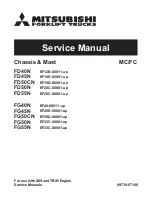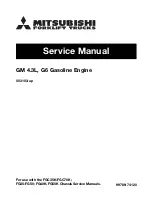
9
9
5.3 Body components (Fig. 1.2)
5.3 Body components (Fig. 1.2)
No.
No.
Name
Name
Operation
Operation and
and attention
attention
1
1
Operator’s seat
Operator’s seat
(Fig. 1.2-14)
(Fig. 1.2-14)
The operator’s seat and seat belt are provided for your
The operator’s seat and seat belt are provided for your
safety.
safety.
The seat can be moved back and forth for position
The seat can be moved back and forth for position
adjustment while the adjust lever is pulled right.
adjustment while the adjust lever is pulled right.
2
2
Engine
Engine hood
hood (Fig.
(Fig. 1.2-12)
1.2-12)
(1) Engine hood lock release lever
(1) Engine hood lock release lever
(1) Push
(1) Push
Opening
Opening
:
:
1. Pulling up on the engine hood lock release lever will
1. Pulling up on the engine hood lock release lever will
release the engine hood lock, and the engine hood will pop
release the engine hood lock, and the engine hood will pop
up slightly.
up slightly.
2. Lift the engine hood.
2. Lift the engine hood.
3. Open the engine hood all the way, then shake the hood
3. Open the engine hood all the way, then shake the hood
slightly to check that the hood damper has been securely
slightly to check that the hood damper has been securely
fastened before letting go.
fastened before letting go.
Closing:
Closing:
1. Lifting up the engine hood and press the hood damper
1. Lifting up the engine hood and press the hood damper
lock to release the lock.
lock to release the lock.
2. Close the engine hood quietly, and press down on the
2. Close the engine hood quietly, and press down on the
hood until you hear a clicki
hood until you hear a clicking sound.
ng sound.
Caution:
Caution:
Operating the vehicle without firm locking of the engine
Operating the vehicle without firm locking of the engine
hood is very dangerous. Be sure to check firm locking
hood is very dangerous. Be sure to check firm locking
before operating the vehicle.
before operating the vehicle.
3
3
Fork
Fork (Fig.
(Fig. 1.2-8)
1.2-8)
(1) Fork stopper
(1) Fork stopper
Lift each fork stopper and turn to release so that forks can
Lift each fork stopper and turn to release so that forks can
be moved left and right. Adjust the forks in the position
be moved left and right. Adjust the forks in the position
most appropriate for the load.
most appropriate for the load.
When adjusting the forks, make sure that the center of
When adjusting the forks, make sure that the center of
gravity of the load corresponds to the center of the
gravity of the load corresponds to the center of the vehicle.
vehicle.
After
After adjustmen
adjustment,
t, turn
turn the
the stoppers
stoppers to
to lock
lock the
the forks
forks in
in
place.
place.
Warning:
Warning:
Make the forks are locked before carrying load.
Make the forks are locked before carrying load.
4
4
Draw
Draw bar
bar
The draw bar is located at the back of the counterweight,
The draw bar is located at the back of the counterweight,
and is used to pull the vehicle when its tyres drop into a
and is used to pull the vehicle when its tyres drop into a
gutter. It can also be used for loading the forklift onto a
gutter. It can also be used for loading the forklift onto a
truck or another vehicle.
truck or another vehicle.
Caution:
Caution:
The draw bar should not be used for towing the forklift
The draw bar should not be used for towing the forklift
truck or for towing another vehicle using the forklift
truck or for towing another vehicle using the forklift truck.
truck.
https://www.besttruckmanuals.com/








































